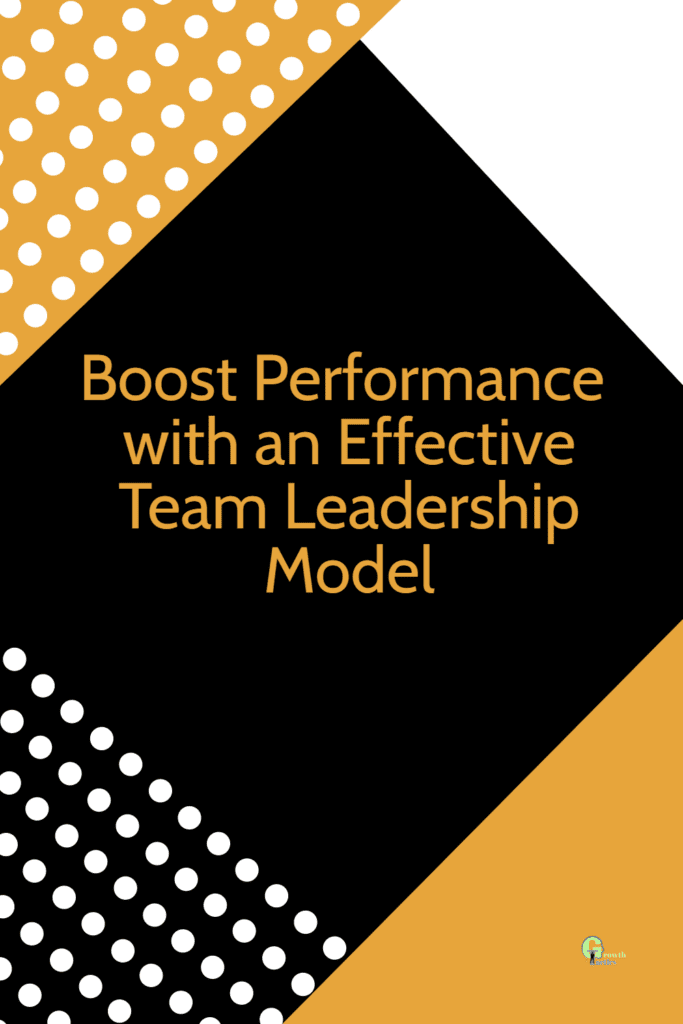“Great leaders are not defined by the absence of weakness, but rather by the presence of clear strengths.” – John Zenger
In today’s fast-paced and collaborative work environment, effective team leadership is crucial for organizational success. A team leadership model provides a framework for guiding and empowering teams towards achieving their goals. This blog post explores the definition and overview of the team leadership model, highlighting its importance in driving collaboration and productivity within organizations. By understanding the core principles of this model, team leaders can enhance their leadership skills and create an environment that fosters innovation, communication, and high-performance teamwork.
Jump To Section
Importance and Benefits of the Team Leadership Model
Enhancing communication and coordination within teams
Effective team leadership models play a crucial role in enhancing communication and coordination within teams. By implementing a structured leadership framework, team members are encouraged to share ideas, opinions, and information openly. This fosters an environment where everyone feels heard and valued, leading to improved collaboration and stronger relationships among team members.
Promoting a positive work culture and employee satisfaction
A well-defined team leadership model promotes a positive work culture essential for employee satisfaction. When leaders prioritize transparency, trust, and respect, it creates an atmosphere where employees feel motivated to contribute their best efforts. This not only boosts morale but also increases productivity and job satisfaction levels among team members.
Achieving higher levels of innovation and problem-solving through diverse perspectives
One of the key advantages of implementing a team leadership model is the ability to harness diverse perspectives for innovation and problem-solving. A strong leader encourages different viewpoints from team members with varied backgrounds, experiences, and expertise. This diversity leads to more creative solutions as individuals bring unique insights to the table. By embracing this approach, teams can tackle challenges more effectively while fostering a culture of continuous improvement.

Key Dimensions of Team Effectiveness in the Model
To achieve team effectiveness, the team leadership model emphasizes several key dimensions that are crucial for success. Let’s take a closer look at these dimensions:
Clear goals and roles for each team member
One of the fundamental aspects of an effective team is having clear goals and well-defined roles for each team member. Understanding their responsibilities and how they contribute to the overall objectives fosters a sense of purpose and direction within the team.
Open and transparent communication channels
Effective communication is vital for any team to thrive. In the team leadership model, open and transparent communication channels play a significant role in ensuring that information flows freely among team members. This allows for effective collaboration, problem-solving, and decision-making.
Trust, respect, and support among team members
Building trust, fostering mutual respect, and providing support are essential elements of an effective team. When there is trust among teammates, it creates an environment where individuals feel comfortable sharing ideas, taking risks, and supporting one another. This leads to increased productivity, quality outcomes, job satisfaction, and overall team cohesion.
By incorporating these dimensions into the team leadership model, teams can enhance their ability to work together cohesively towards shared goals. The clarity of goals combined with open communication channels promotes efficiency in task completion. When trust is established among teammates through respect and support, it positively impacts both relational dynamics within the group as well as external perceptions of success.
Enhancing Team Performance through the Model
Providing regular feedback and performance evaluations
Regular feedback and performance evaluations play a crucial role in enhancing team performance. By providing constructive feedback, team leaders can address areas of improvement and reinforce positive behaviors. This feedback loop helps team members understand their strengths and weaknesses, enabling them to make necessary adjustments for growth. Performance evaluations provide an opportunity to recognize individual contributions and celebrate achievements, fostering a sense of accomplishment within the team.
Encouraging skill development and continuous learning opportunities
Effective team leadership involves encouraging skill development and providing continuous learning opportunities for team members. By investing in their professional growth, leaders empower individuals to expand their knowledge base and acquire new skills that align with the team’s objectives. This not only enhances individual capabilities but also contributes to the overall expertise of the team. Leaders can facilitate skill development through training programs, workshops, mentorship initiatives, or by encouraging self-directed learning.
Implementing strategies to manage conflicts effectively within the team
Conflict is inevitable within any group dynamic; however, effective leaders implement strategies to manage conflicts constructively. They create an environment where open communication is encouraged, allowing team members to express their concerns or disagreements without fear of judgment or reprisal. Through active listening and mediation techniques, leaders can help resolve conflicts before they escalate into larger issues that hinder teamwork and productivity.
By addressing conflicts head-on and promoting healthy dialogue among team members, leaders foster an atmosphere of trust and mutual accountability. This enables individuals to work collaboratively towards a common goal while embracing diverse perspectives.

Practical Application of the Team Leadership Model
Creating a Shared Vision and Mission Statement for the Team
A crucial aspect of effective team leadership is creating a shared vision and mission statement. This helps align team members towards a common goal, fostering unity and clarity in their work. By involving the entire team in this process, each member feels a sense of ownership and commitment to the vision.
To implement this, the team leader can facilitate brainstorming sessions or conduct surveys to gather input from team members. Through open communication and collaboration, the team can collectively define their purpose, values, and long-term objectives. This shared vision provides a guiding compass that motivates individuals to work together toward achieving their goals.
Establishing Accountability Measures to Track Progress Towards Goals
Accountability is vital in any team setting as it ensures that everyone remains focused on their responsibilities and contributes effectively. To establish accountability measures, the team leader can:
- Clearly define roles and responsibilities: Assign specific tasks to each team member, ensuring they understand what is expected of them.
- Set measurable targets: Break down larger goals into smaller milestones that are easier to track progress against.
- Regularly monitor performance: Conduct periodic check-ins or progress reviews where individuals report on their achievements and challenges faced.
- Provide constructive feedback: Offer guidance and support when necessary while recognizing accomplishments.
By implementing these accountability measures, teams can maintain momentum toward their objectives while addressing any issues or roadblocks that arise along the way.
Utilizing Technology Tools for Efficient Collaboration and Project Management
In today’s digital age, technology tools play a vital role in enhancing collaboration and project management within teams. Leveraging tools such as project management software, communication platforms, and file-sharing systems can streamline workflows and improve overall efficiency.
Some benefits of using technology tools include:
- Enhanced communication: Instant messaging platforms allow for quick exchanges of information while video conferencing facilitates face-to-face interactions regardless of physical location.
- Centralized project management: Project management software enables teams to track tasks, deadlines, and progress in one centralized location, promoting transparency and accountability.
- Efficient file sharing: Cloud-based storage systems enable seamless sharing and collaboration on documents, reducing the need for lengthy email threads or physical handoffs.
By harnessing the power of technology tools, teams can optimize their workflows, improve communication, and ultimately achieve their goals more efficiently.
Exploring Different Models of Team Leadership
In the world of team leadership, there are various models and styles that leaders can adopt to guide their teams toward success. Let’s delve into some of these different approaches and understand how they can be applied in different situations.
Overview of Various Leadership Styles
Leadership styles play a crucial role in shaping the dynamics within a team. Some common leadership styles include democratic leadership, where decision-making is shared among team members, and transformational leadership, which focuses on inspiring and motivating the team to achieve their goals. Each style has its strengths and weaknesses, and understanding them can help leaders adapt their approach based on the needs of their team.
Situational Leadership Approaches
Situational leadership recognizes that different contexts or challenges teams face may require different leadership approaches. This means that leaders need to be flexible and adaptable in their strategies. They must assess the situation at hand, consider the capabilities and readiness of their team members, and adjust their leadership style accordingly. By doing so, leaders can effectively address problems, provide insights, assign roles, and seize growth opportunities.
Maximizing Strengths-Based Leadership Models
Strengths-based leadership models focus on leveraging individual talents within a team to maximize overall performance. Instead of trying to fix weaknesses or shortcomings, these models encourage leaders to identify and nurture each team member’s unique strengths. By aligning tasks with individuals’ strengths, leaders can create an environment where everyone feels valued and empowered to contribute their best work.
By exploring different models of team leadership such as democratic or transformational styles, utilizing situational approaches based on specific contexts or challenges faced by teams, and maximizing strengths-based leadership models to leverage individual talents within a team; leaders can foster collaboration, boost productivity, and drive success for their teams.
Maximizing Team Effectiveness with the Leadership Model
Congratulations! You now have a solid understanding of how the team leadership model can maximize team effectiveness. By incorporating key dimensions such as clear communication, shared goals, and effective decision-making, you can enhance your team’s performance and achieve remarkable results.
To put this knowledge into action, start by identifying areas where your team could benefit from improved leadership. Consider implementing the team leadership model to foster collaboration, boost motivation, and drive innovation. Remember, effective leadership is not just about leading from the front but also empowering your team members to unleash their full potential.
Now it’s time for you to take charge and become an exceptional leader. Embrace the principles of the team leadership model and watch as your team flourishes under your guidance. Together, you can overcome any challenge and achieve greatness!


